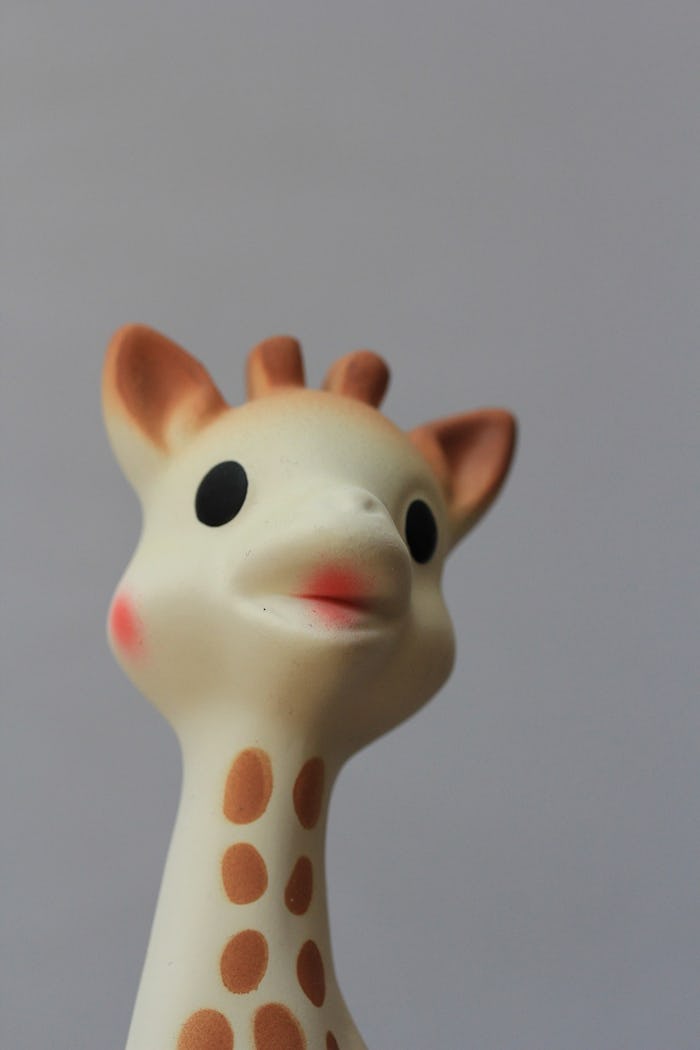Parents worldwide have been slicing open the throats of popular rubber teething toys lately, worried about what they might find inside due to recent reports of mold. (Gruesome.) But if you're not ready to whip out the scissors just yet, you'll want to know how to check if your Sophie the Giraffe has mold — that is, without cutting her open.
First, it's important to note that not all Sophie toys will have this problem. In a statement to Good Housekeeping, which published one of the first reports of the mold on Tuesday, spokespersons from the company that makes Sophie explained the situation, saying:
It’s important to know that Sophie la girafe is composed of 100% natural rubber, so the cleaning instructions have to be carefully respected. As indicated on the packaging and in an explanatory leaflet inside the packaging, we recommend to clean the surface of Sophie la girafe with a damp cloth. It should not be immersed in the water nor rinsed off, to prevent water from getting inside, as she may become damaged. We thus would like to emphasize on the fact that is it important, while cleaning the product, that no water gets inside the whole. Furthermore, please know that the safety of children and satisfaction of their parents is our main priority. For the past 55 years, we have always strived to exceed security standards and all of our products comply with the most stringent global standards.
In an email to Romper, a Sophie the Giraffe spokesperson reiterated the statement previously given to Good Housekeeping. "It's an isolated issue it's probably due to improper storage and improper care of the product," they said. Calisson Inc., the U.S. distributor for Sophie's parent company, Vulli, told NBC of the mold on Wednesday,
Based on the assessment the 'Sophie la girafe' quality department can make from the pictures shown in the [Good Housekeeping] article, it is not possible that saliva could cause the type of mold formation shown in the pictures. Internal studies have been conducted and indicated that it is improbable (or in really rare cases) that saliva can transform into mold. It seems that the inside body of the giraffe is still wet, which leads us to believe that there was presence of water inside the giraffe, which caused the mold. This situation is often seen with bath toys.
By these estimations, then, proper care, dry upkeep, and storage of the toy should dissolve all worry of a potentially moldy giraffe. Regardless, the medical consensus is that the Sophie the giraffe mold is harmless, "unless the child has an extremely susceptible immune system," the BBC reports.
Still, it's understandable why someone wouldn't want to let their toddler continue teething on a moldy toy. Stephanie Oprea, who shared her experience the contaminated giraffe toy with Good Housekeeping, recalled noticing "a bit of a smell" before opening her toy up to find mold. Similarly, Dana Chianese "noticed the air coming out of the hole smelled musty," Good Housekeeping shared. Based on these assessments, if your toy is odor-free, than it's likely that you're safe, no cutting needed.
Smell seems to be the key to Sophie's safety. Remember, though, "It's unlikely that mold in a toy is harmful to children," Dr. Amesh Adalja, an infectious-disease specialist at the University of Pittsburgh Medical Center, told Live Science. "For the vast majority of humans, most molds pose no significant threats to them," Adalja shared.
So, despite all the harrowing, mold-infested accounts, it seems like this situation isn't one worth worrying about, if your teething product has been cleaned properly. And if you notice a musty scent coming from your child's Sophie toy? Break out the scissors... it seems, for now, that's the only way to solve the mystery in the end.
